Business Strategy: Analyzing Macro and Internal Environment of Marks & Spencer
VerifiedAdded on 2023/06/12
|14
|4488
|366
AI Summary
This report analyzes the impact of macro environment on business strategies of Marks & Spencer. It evaluates the internal capabilities of the company using appropriate frameworks and uses Porter's five forces to evaluate competitive forces of a market sector for the firm.
Contribute Materials
Your contribution can guide someone’s learning journey. Share your
documents today.
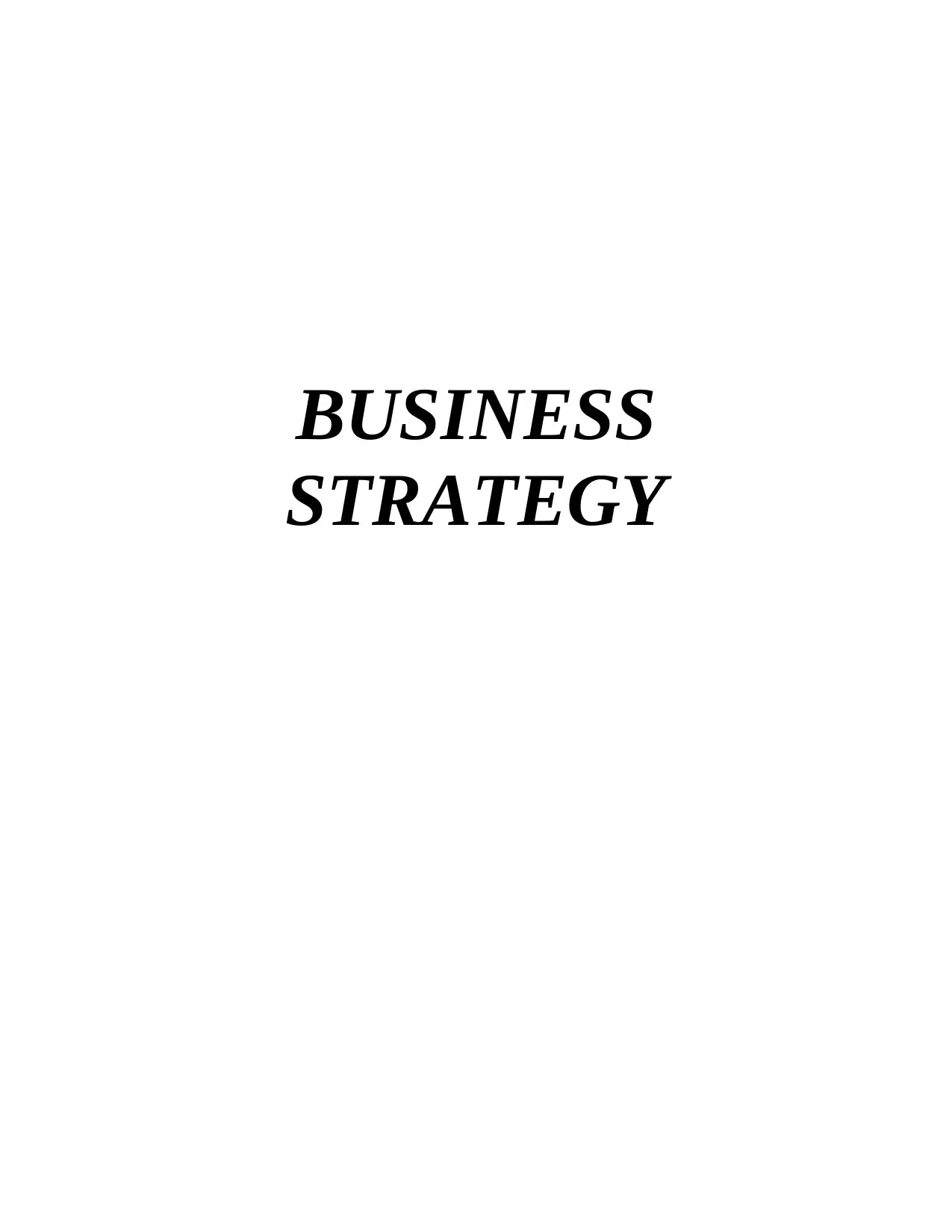
BUSINESS
STRATEGY
STRATEGY
Secure Best Marks with AI Grader
Need help grading? Try our AI Grader for instant feedback on your assignments.
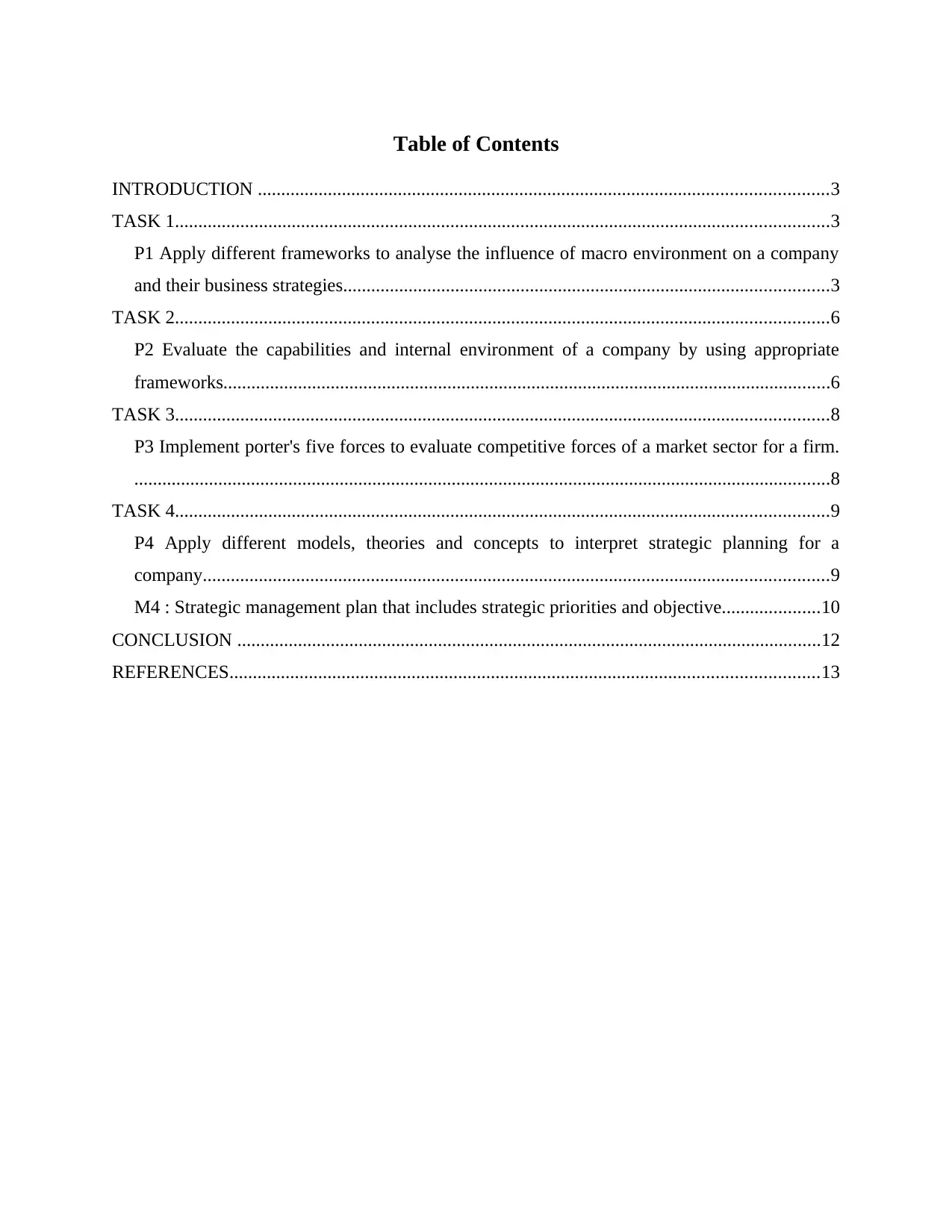
Table of Contents
INTRODUCTION ..........................................................................................................................3
TASK 1............................................................................................................................................3
P1 Apply different frameworks to analyse the influence of macro environment on a company
and their business strategies........................................................................................................3
TASK 2............................................................................................................................................6
P2 Evaluate the capabilities and internal environment of a company by using appropriate
frameworks..................................................................................................................................6
TASK 3............................................................................................................................................8
P3 Implement porter's five forces to evaluate competitive forces of a market sector for a firm.
.....................................................................................................................................................8
TASK 4............................................................................................................................................9
P4 Apply different models, theories and concepts to interpret strategic planning for a
company......................................................................................................................................9
M4 : Strategic management plan that includes strategic priorities and objective.....................10
CONCLUSION .............................................................................................................................12
REFERENCES..............................................................................................................................13
INTRODUCTION ..........................................................................................................................3
TASK 1............................................................................................................................................3
P1 Apply different frameworks to analyse the influence of macro environment on a company
and their business strategies........................................................................................................3
TASK 2............................................................................................................................................6
P2 Evaluate the capabilities and internal environment of a company by using appropriate
frameworks..................................................................................................................................6
TASK 3............................................................................................................................................8
P3 Implement porter's five forces to evaluate competitive forces of a market sector for a firm.
.....................................................................................................................................................8
TASK 4............................................................................................................................................9
P4 Apply different models, theories and concepts to interpret strategic planning for a
company......................................................................................................................................9
M4 : Strategic management plan that includes strategic priorities and objective.....................10
CONCLUSION .............................................................................................................................12
REFERENCES..............................................................................................................................13
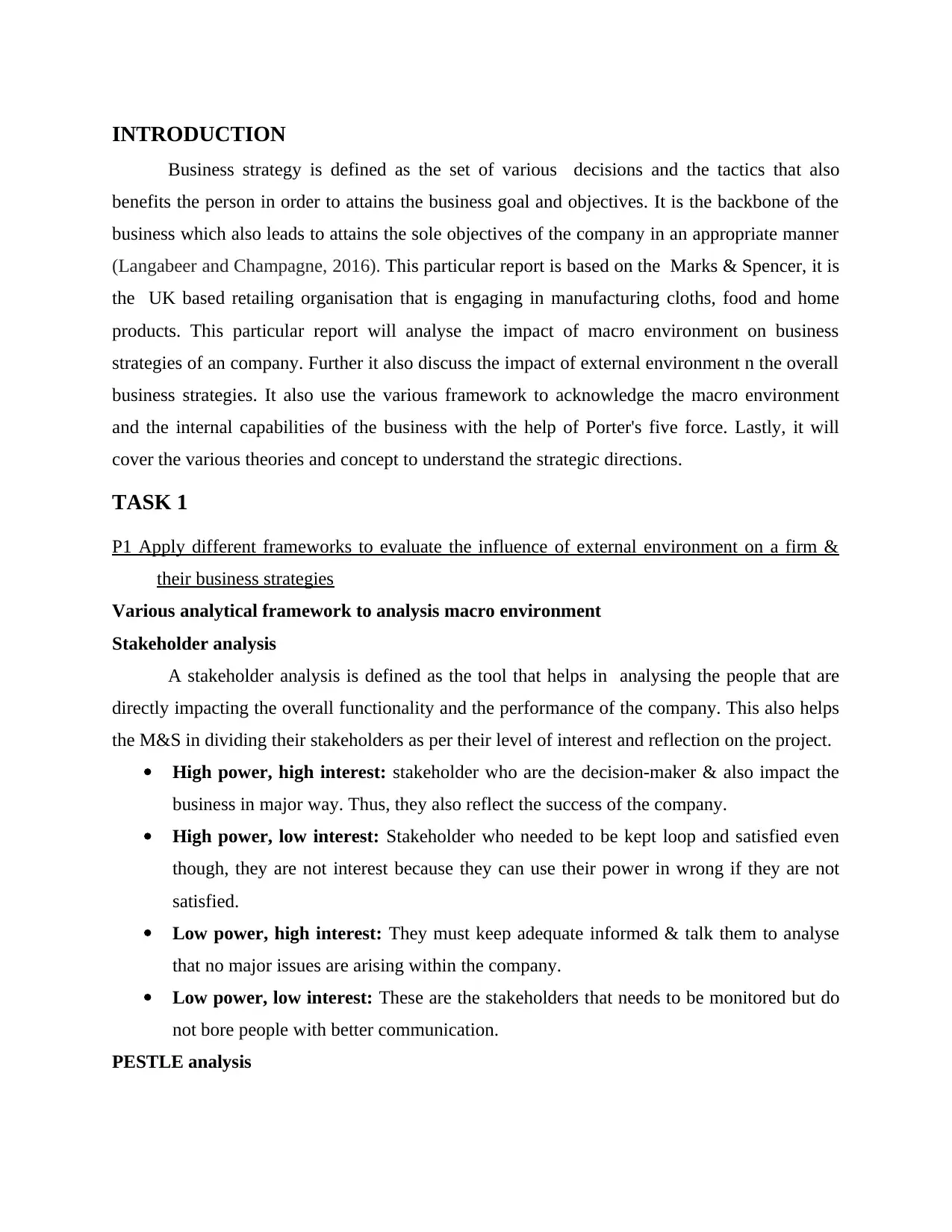
INTRODUCTION
Business strategy is defined as the set of various decisions and the tactics that also
benefits the person in order to attains the business goal and objectives. It is the backbone of the
business which also leads to attains the sole objectives of the company in an appropriate manner
(Langabeer and Champagne, 2016). This particular report is based on the Marks & Spencer, it is
the UK based retailing organisation that is engaging in manufacturing cloths, food and home
products. This particular report will analyse the impact of macro environment on business
strategies of an company. Further it also discuss the impact of external environment n the overall
business strategies. It also use the various framework to acknowledge the macro environment
and the internal capabilities of the business with the help of Porter's five force. Lastly, it will
cover the various theories and concept to understand the strategic directions.
TASK 1
P1 Apply different frameworks to evaluate the influence of external environment on a firm &
their business strategies
Various analytical framework to analysis macro environment
Stakeholder analysis
A stakeholder analysis is defined as the tool that helps in analysing the people that are
directly impacting the overall functionality and the performance of the company. This also helps
the M&S in dividing their stakeholders as per their level of interest and reflection on the project.
High power, high interest: stakeholder who are the decision-maker & also impact the
business in major way. Thus, they also reflect the success of the company.
High power, low interest: Stakeholder who needed to be kept loop and satisfied even
though, they are not interest because they can use their power in wrong if they are not
satisfied.
Low power, high interest: They must keep adequate informed & talk them to analyse
that no major issues are arising within the company.
Low power, low interest: These are the stakeholders that needs to be monitored but do
not bore people with better communication.
PESTLE analysis
Business strategy is defined as the set of various decisions and the tactics that also
benefits the person in order to attains the business goal and objectives. It is the backbone of the
business which also leads to attains the sole objectives of the company in an appropriate manner
(Langabeer and Champagne, 2016). This particular report is based on the Marks & Spencer, it is
the UK based retailing organisation that is engaging in manufacturing cloths, food and home
products. This particular report will analyse the impact of macro environment on business
strategies of an company. Further it also discuss the impact of external environment n the overall
business strategies. It also use the various framework to acknowledge the macro environment
and the internal capabilities of the business with the help of Porter's five force. Lastly, it will
cover the various theories and concept to understand the strategic directions.
TASK 1
P1 Apply different frameworks to evaluate the influence of external environment on a firm &
their business strategies
Various analytical framework to analysis macro environment
Stakeholder analysis
A stakeholder analysis is defined as the tool that helps in analysing the people that are
directly impacting the overall functionality and the performance of the company. This also helps
the M&S in dividing their stakeholders as per their level of interest and reflection on the project.
High power, high interest: stakeholder who are the decision-maker & also impact the
business in major way. Thus, they also reflect the success of the company.
High power, low interest: Stakeholder who needed to be kept loop and satisfied even
though, they are not interest because they can use their power in wrong if they are not
satisfied.
Low power, high interest: They must keep adequate informed & talk them to analyse
that no major issues are arising within the company.
Low power, low interest: These are the stakeholders that needs to be monitored but do
not bore people with better communication.
PESTLE analysis
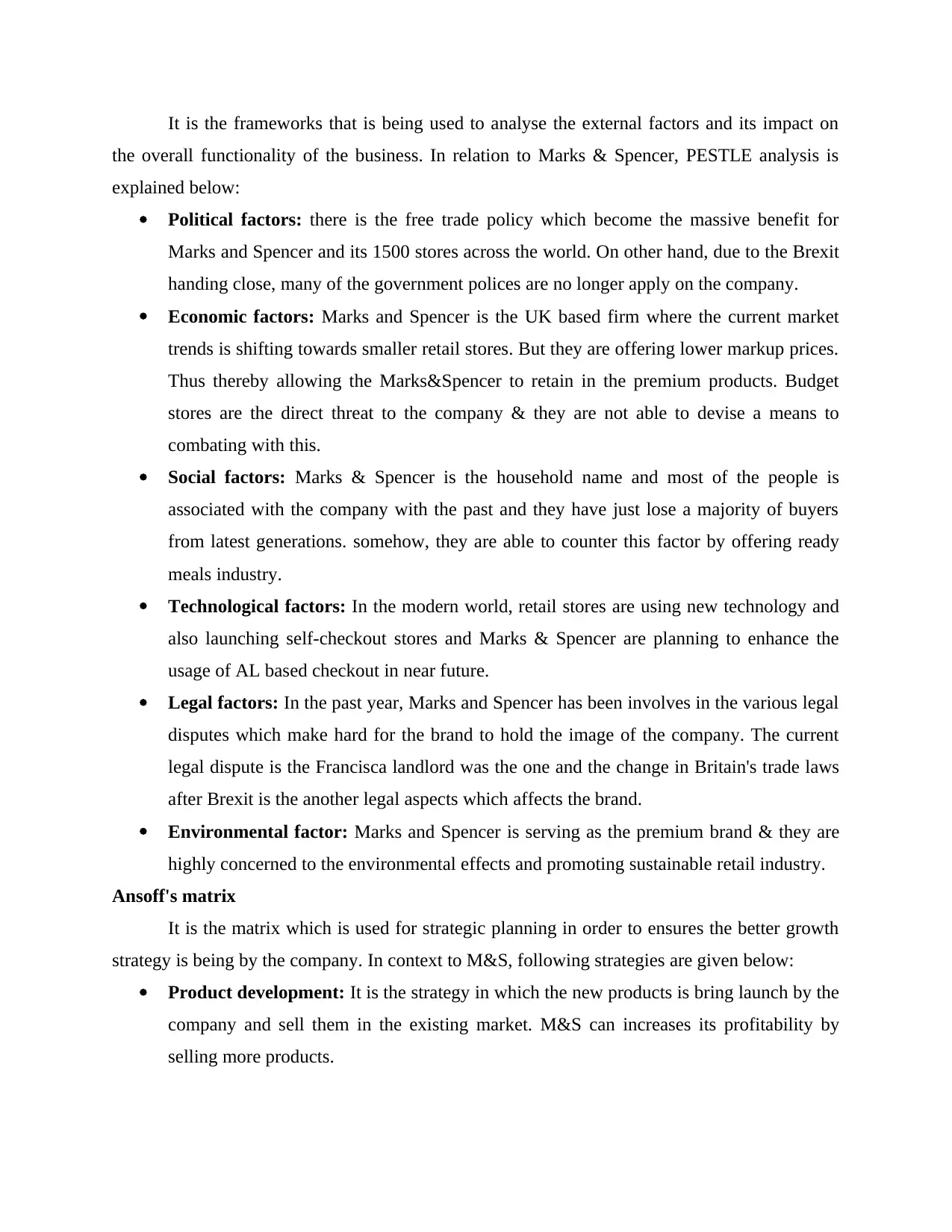
It is the frameworks that is being used to analyse the external factors and its impact on
the overall functionality of the business. In relation to Marks & Spencer, PESTLE analysis is
explained below:
Political factors: there is the free trade policy which become the massive benefit for
Marks and Spencer and its 1500 stores across the world. On other hand, due to the Brexit
handing close, many of the government polices are no longer apply on the company.
Economic factors: Marks and Spencer is the UK based firm where the current market
trends is shifting towards smaller retail stores. But they are offering lower markup prices.
Thus thereby allowing the Marks&Spencer to retain in the premium products. Budget
stores are the direct threat to the company & they are not able to devise a means to
combating with this.
Social factors: Marks & Spencer is the household name and most of the people is
associated with the company with the past and they have just lose a majority of buyers
from latest generations. somehow, they are able to counter this factor by offering ready
meals industry.
Technological factors: In the modern world, retail stores are using new technology and
also launching self-checkout stores and Marks & Spencer are planning to enhance the
usage of AL based checkout in near future.
Legal factors: In the past year, Marks and Spencer has been involves in the various legal
disputes which make hard for the brand to hold the image of the company. The current
legal dispute is the Francisca landlord was the one and the change in Britain's trade laws
after Brexit is the another legal aspects which affects the brand.
Environmental factor: Marks and Spencer is serving as the premium brand & they are
highly concerned to the environmental effects and promoting sustainable retail industry.
Ansoff's matrix
It is the matrix which is used for strategic planning in order to ensures the better growth
strategy is being by the company. In context to M&S, following strategies are given below:
Product development: It is the strategy in which the new products is bring launch by the
company and sell them in the existing market. M&S can increases its profitability by
selling more products.
the overall functionality of the business. In relation to Marks & Spencer, PESTLE analysis is
explained below:
Political factors: there is the free trade policy which become the massive benefit for
Marks and Spencer and its 1500 stores across the world. On other hand, due to the Brexit
handing close, many of the government polices are no longer apply on the company.
Economic factors: Marks and Spencer is the UK based firm where the current market
trends is shifting towards smaller retail stores. But they are offering lower markup prices.
Thus thereby allowing the Marks&Spencer to retain in the premium products. Budget
stores are the direct threat to the company & they are not able to devise a means to
combating with this.
Social factors: Marks & Spencer is the household name and most of the people is
associated with the company with the past and they have just lose a majority of buyers
from latest generations. somehow, they are able to counter this factor by offering ready
meals industry.
Technological factors: In the modern world, retail stores are using new technology and
also launching self-checkout stores and Marks & Spencer are planning to enhance the
usage of AL based checkout in near future.
Legal factors: In the past year, Marks and Spencer has been involves in the various legal
disputes which make hard for the brand to hold the image of the company. The current
legal dispute is the Francisca landlord was the one and the change in Britain's trade laws
after Brexit is the another legal aspects which affects the brand.
Environmental factor: Marks and Spencer is serving as the premium brand & they are
highly concerned to the environmental effects and promoting sustainable retail industry.
Ansoff's matrix
It is the matrix which is used for strategic planning in order to ensures the better growth
strategy is being by the company. In context to M&S, following strategies are given below:
Product development: It is the strategy in which the new products is bring launch by the
company and sell them in the existing market. M&S can increases its profitability by
selling more products.
Secure Best Marks with AI Grader
Need help grading? Try our AI Grader for instant feedback on your assignments.
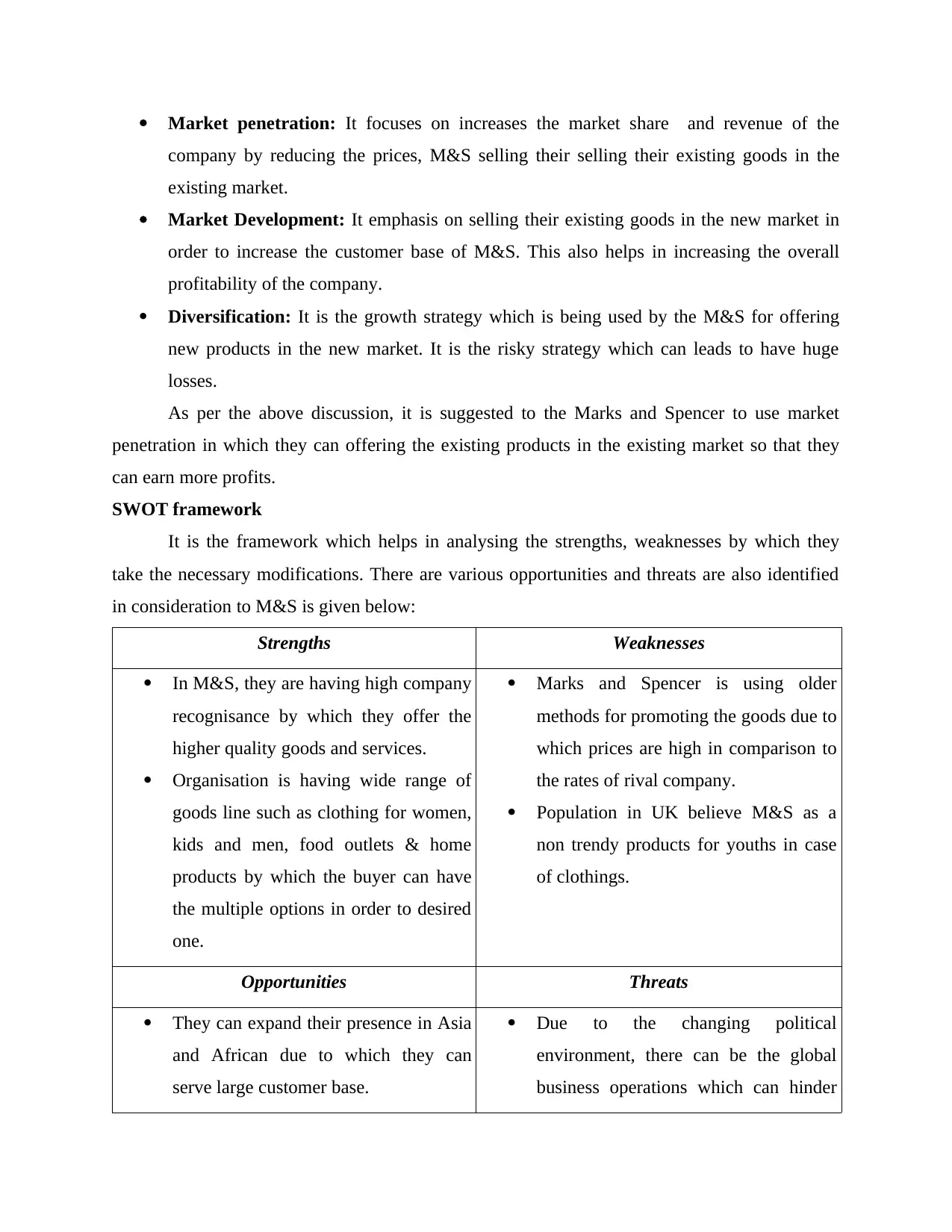
Market penetration: It focuses on increases the market share and revenue of the
company by reducing the prices, M&S selling their selling their existing goods in the
existing market.
Market Development: It emphasis on selling their existing goods in the new market in
order to increase the customer base of M&S. This also helps in increasing the overall
profitability of the company.
Diversification: It is the growth strategy which is being used by the M&S for offering
new products in the new market. It is the risky strategy which can leads to have huge
losses.
As per the above discussion, it is suggested to the Marks and Spencer to use market
penetration in which they can offering the existing products in the existing market so that they
can earn more profits.
SWOT framework
It is the framework which helps in analysing the strengths, weaknesses by which they
take the necessary modifications. There are various opportunities and threats are also identified
in consideration to M&S is given below:
Strengths Weaknesses
In M&S, they are having high company
recognisance by which they offer the
higher quality goods and services.
Organisation is having wide range of
goods line such as clothing for women,
kids and men, food outlets & home
products by which the buyer can have
the multiple options in order to desired
one.
Marks and Spencer is using older
methods for promoting the goods due to
which prices are high in comparison to
the rates of rival company.
Population in UK believe M&S as a
non trendy products for youths in case
of clothings.
Opportunities Threats
They can expand their presence in Asia
and African due to which they can
serve large customer base.
Due to the changing political
environment, there can be the global
business operations which can hinder
company by reducing the prices, M&S selling their selling their existing goods in the
existing market.
Market Development: It emphasis on selling their existing goods in the new market in
order to increase the customer base of M&S. This also helps in increasing the overall
profitability of the company.
Diversification: It is the growth strategy which is being used by the M&S for offering
new products in the new market. It is the risky strategy which can leads to have huge
losses.
As per the above discussion, it is suggested to the Marks and Spencer to use market
penetration in which they can offering the existing products in the existing market so that they
can earn more profits.
SWOT framework
It is the framework which helps in analysing the strengths, weaknesses by which they
take the necessary modifications. There are various opportunities and threats are also identified
in consideration to M&S is given below:
Strengths Weaknesses
In M&S, they are having high company
recognisance by which they offer the
higher quality goods and services.
Organisation is having wide range of
goods line such as clothing for women,
kids and men, food outlets & home
products by which the buyer can have
the multiple options in order to desired
one.
Marks and Spencer is using older
methods for promoting the goods due to
which prices are high in comparison to
the rates of rival company.
Population in UK believe M&S as a
non trendy products for youths in case
of clothings.
Opportunities Threats
They can expand their presence in Asia
and African due to which they can
serve large customer base.
Due to the changing political
environment, there can be the global
business operations which can hinder
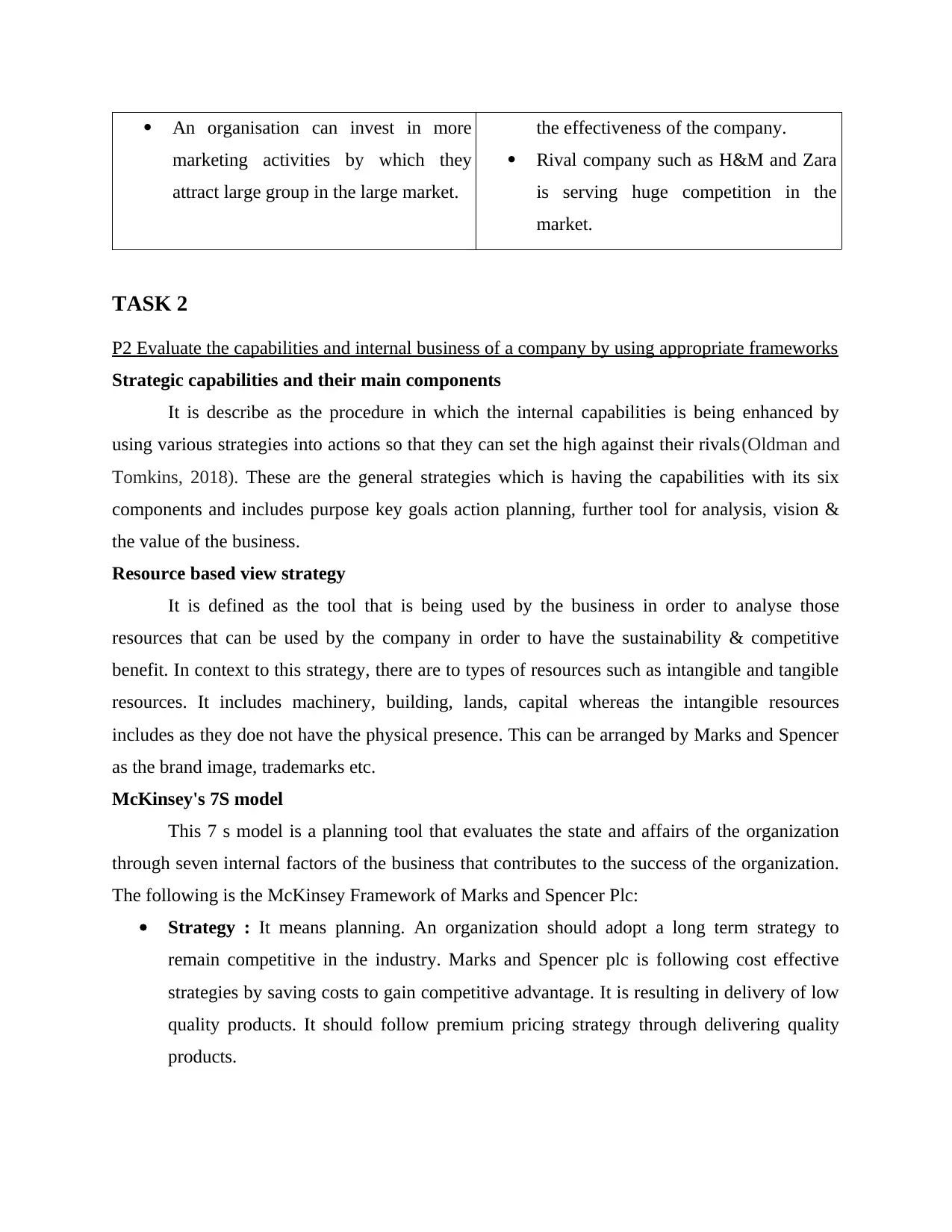
An organisation can invest in more
marketing activities by which they
attract large group in the large market.
the effectiveness of the company.
Rival company such as H&M and Zara
is serving huge competition in the
market.
TASK 2
P2 Evaluate the capabilities and internal business of a company by using appropriate frameworks
Strategic capabilities and their main components
It is describe as the procedure in which the internal capabilities is being enhanced by
using various strategies into actions so that they can set the high against their rivals(Oldman and
Tomkins, 2018). These are the general strategies which is having the capabilities with its six
components and includes purpose key goals action planning, further tool for analysis, vision &
the value of the business.
Resource based view strategy
It is defined as the tool that is being used by the business in order to analyse those
resources that can be used by the company in order to have the sustainability & competitive
benefit. In context to this strategy, there are to types of resources such as intangible and tangible
resources. It includes machinery, building, lands, capital whereas the intangible resources
includes as they doe not have the physical presence. This can be arranged by Marks and Spencer
as the brand image, trademarks etc.
McKinsey's 7S model
This 7 s model is a planning tool that evaluates the state and affairs of the organization
through seven internal factors of the business that contributes to the success of the organization.
The following is the McKinsey Framework of Marks and Spencer Plc:
Strategy : It means planning. An organization should adopt a long term strategy to
remain competitive in the industry. Marks and Spencer plc is following cost effective
strategies by saving costs to gain competitive advantage. It is resulting in delivery of low
quality products. It should follow premium pricing strategy through delivering quality
products.
marketing activities by which they
attract large group in the large market.
the effectiveness of the company.
Rival company such as H&M and Zara
is serving huge competition in the
market.
TASK 2
P2 Evaluate the capabilities and internal business of a company by using appropriate frameworks
Strategic capabilities and their main components
It is describe as the procedure in which the internal capabilities is being enhanced by
using various strategies into actions so that they can set the high against their rivals(Oldman and
Tomkins, 2018). These are the general strategies which is having the capabilities with its six
components and includes purpose key goals action planning, further tool for analysis, vision &
the value of the business.
Resource based view strategy
It is defined as the tool that is being used by the business in order to analyse those
resources that can be used by the company in order to have the sustainability & competitive
benefit. In context to this strategy, there are to types of resources such as intangible and tangible
resources. It includes machinery, building, lands, capital whereas the intangible resources
includes as they doe not have the physical presence. This can be arranged by Marks and Spencer
as the brand image, trademarks etc.
McKinsey's 7S model
This 7 s model is a planning tool that evaluates the state and affairs of the organization
through seven internal factors of the business that contributes to the success of the organization.
The following is the McKinsey Framework of Marks and Spencer Plc:
Strategy : It means planning. An organization should adopt a long term strategy to
remain competitive in the industry. Marks and Spencer plc is following cost effective
strategies by saving costs to gain competitive advantage. It is resulting in delivery of low
quality products. It should follow premium pricing strategy through delivering quality
products.
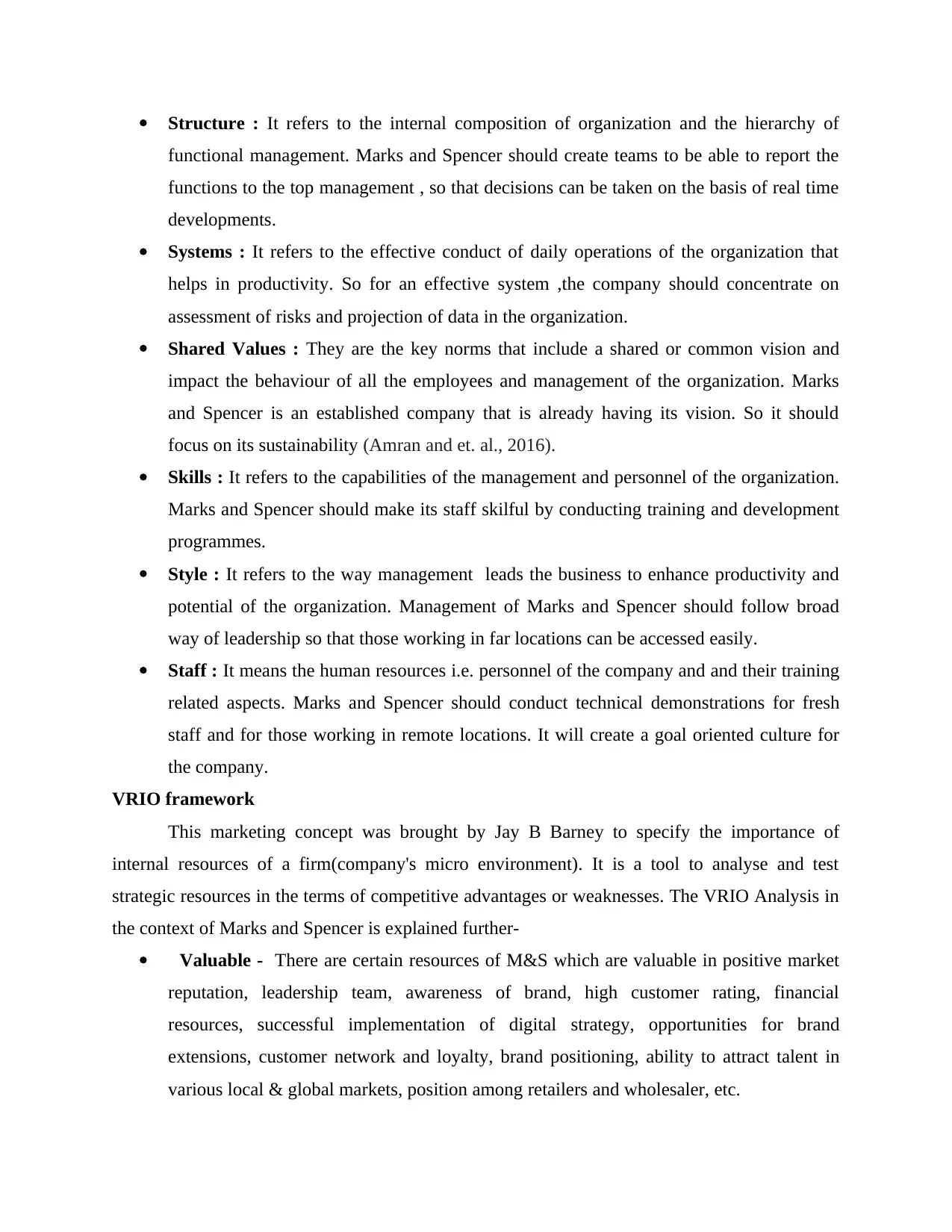
Structure : It refers to the internal composition of organization and the hierarchy of
functional management. Marks and Spencer should create teams to be able to report the
functions to the top management , so that decisions can be taken on the basis of real time
developments.
Systems : It refers to the effective conduct of daily operations of the organization that
helps in productivity. So for an effective system ,the company should concentrate on
assessment of risks and projection of data in the organization.
Shared Values : They are the key norms that include a shared or common vision and
impact the behaviour of all the employees and management of the organization. Marks
and Spencer is an established company that is already having its vision. So it should
focus on its sustainability (Amran and et. al., 2016).
Skills : It refers to the capabilities of the management and personnel of the organization.
Marks and Spencer should make its staff skilful by conducting training and development
programmes.
Style : It refers to the way management leads the business to enhance productivity and
potential of the organization. Management of Marks and Spencer should follow broad
way of leadership so that those working in far locations can be accessed easily.
Staff : It means the human resources i.e. personnel of the company and and their training
related aspects. Marks and Spencer should conduct technical demonstrations for fresh
staff and for those working in remote locations. It will create a goal oriented culture for
the company.
VRIO framework
This marketing concept was brought by Jay B Barney to specify the importance of
internal resources of a firm(company's micro environment). It is a tool to analyse and test
strategic resources in the terms of competitive advantages or weaknesses. The VRIO Analysis in
the context of Marks and Spencer is explained further-
Valuable - There are certain resources of M&S which are valuable in positive market
reputation, leadership team, awareness of brand, high customer rating, financial
resources, successful implementation of digital strategy, opportunities for brand
extensions, customer network and loyalty, brand positioning, ability to attract talent in
various local & global markets, position among retailers and wholesaler, etc.
functional management. Marks and Spencer should create teams to be able to report the
functions to the top management , so that decisions can be taken on the basis of real time
developments.
Systems : It refers to the effective conduct of daily operations of the organization that
helps in productivity. So for an effective system ,the company should concentrate on
assessment of risks and projection of data in the organization.
Shared Values : They are the key norms that include a shared or common vision and
impact the behaviour of all the employees and management of the organization. Marks
and Spencer is an established company that is already having its vision. So it should
focus on its sustainability (Amran and et. al., 2016).
Skills : It refers to the capabilities of the management and personnel of the organization.
Marks and Spencer should make its staff skilful by conducting training and development
programmes.
Style : It refers to the way management leads the business to enhance productivity and
potential of the organization. Management of Marks and Spencer should follow broad
way of leadership so that those working in far locations can be accessed easily.
Staff : It means the human resources i.e. personnel of the company and and their training
related aspects. Marks and Spencer should conduct technical demonstrations for fresh
staff and for those working in remote locations. It will create a goal oriented culture for
the company.
VRIO framework
This marketing concept was brought by Jay B Barney to specify the importance of
internal resources of a firm(company's micro environment). It is a tool to analyse and test
strategic resources in the terms of competitive advantages or weaknesses. The VRIO Analysis in
the context of Marks and Spencer is explained further-
Valuable - There are certain resources of M&S which are valuable in positive market
reputation, leadership team, awareness of brand, high customer rating, financial
resources, successful implementation of digital strategy, opportunities for brand
extensions, customer network and loyalty, brand positioning, ability to attract talent in
various local & global markets, position among retailers and wholesaler, etc.
Paraphrase This Document
Need a fresh take? Get an instant paraphrase of this document with our AI Paraphraser
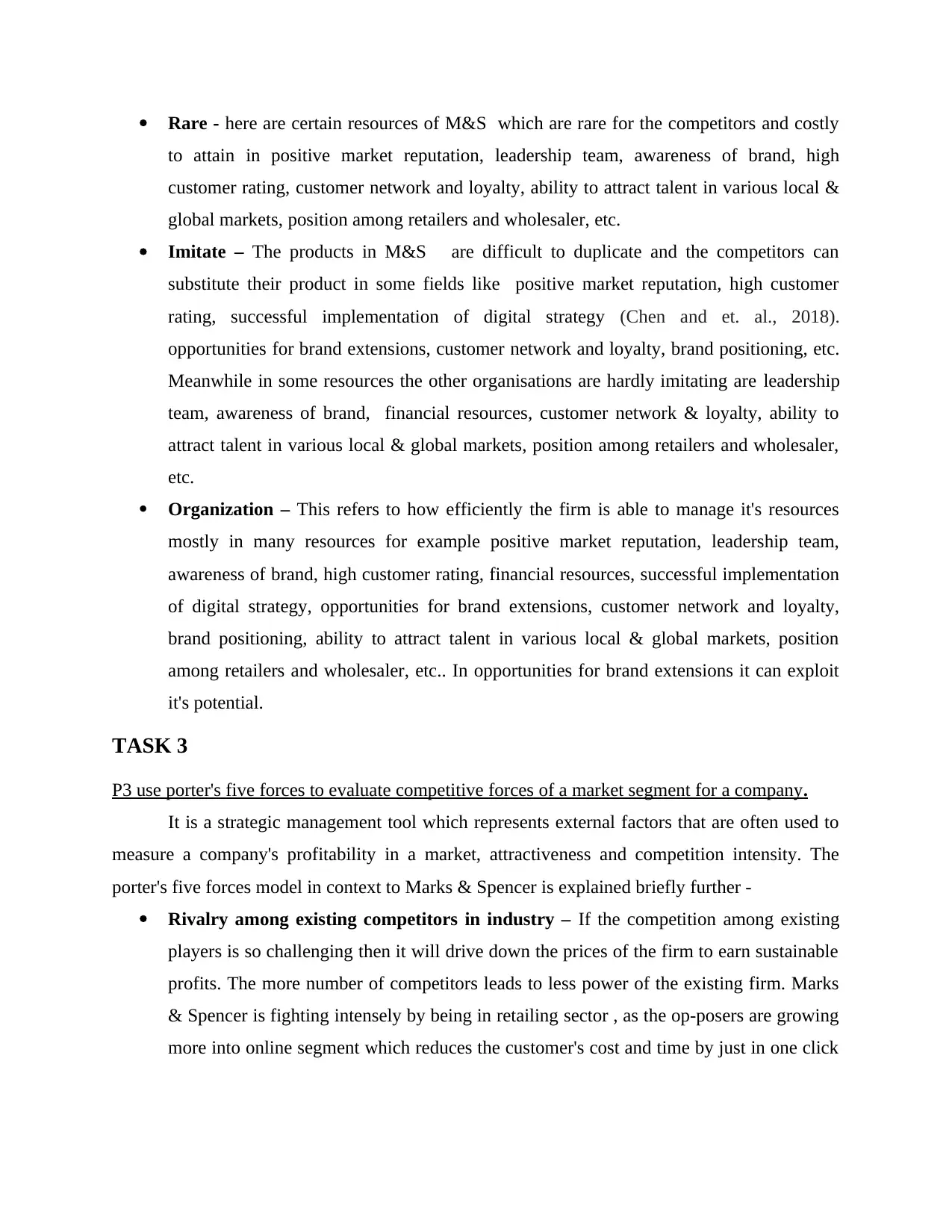
Rare - here are certain resources of M&S which are rare for the competitors and costly
to attain in positive market reputation, leadership team, awareness of brand, high
customer rating, customer network and loyalty, ability to attract talent in various local &
global markets, position among retailers and wholesaler, etc.
Imitate – The products in M&S are difficult to duplicate and the competitors can
substitute their product in some fields like positive market reputation, high customer
rating, successful implementation of digital strategy (Chen and et. al., 2018).
opportunities for brand extensions, customer network and loyalty, brand positioning, etc.
Meanwhile in some resources the other organisations are hardly imitating are leadership
team, awareness of brand, financial resources, customer network & loyalty, ability to
attract talent in various local & global markets, position among retailers and wholesaler,
etc.
Organization – This refers to how efficiently the firm is able to manage it's resources
mostly in many resources for example positive market reputation, leadership team,
awareness of brand, high customer rating, financial resources, successful implementation
of digital strategy, opportunities for brand extensions, customer network and loyalty,
brand positioning, ability to attract talent in various local & global markets, position
among retailers and wholesaler, etc.. In opportunities for brand extensions it can exploit
it's potential.
TASK 3
P3 use porter's five forces to evaluate competitive forces of a market segment for a company.
It is a strategic management tool which represents external factors that are often used to
measure a company's profitability in a market, attractiveness and competition intensity. The
porter's five forces model in context to Marks & Spencer is explained briefly further -
Rivalry among existing competitors in industry – If the competition among existing
players is so challenging then it will drive down the prices of the firm to earn sustainable
profits. The more number of competitors leads to less power of the existing firm. Marks
& Spencer is fighting intensely by being in retailing sector , as the op-posers are growing
more into online segment which reduces the customer's cost and time by just in one click
to attain in positive market reputation, leadership team, awareness of brand, high
customer rating, customer network and loyalty, ability to attract talent in various local &
global markets, position among retailers and wholesaler, etc.
Imitate – The products in M&S are difficult to duplicate and the competitors can
substitute their product in some fields like positive market reputation, high customer
rating, successful implementation of digital strategy (Chen and et. al., 2018).
opportunities for brand extensions, customer network and loyalty, brand positioning, etc.
Meanwhile in some resources the other organisations are hardly imitating are leadership
team, awareness of brand, financial resources, customer network & loyalty, ability to
attract talent in various local & global markets, position among retailers and wholesaler,
etc.
Organization – This refers to how efficiently the firm is able to manage it's resources
mostly in many resources for example positive market reputation, leadership team,
awareness of brand, high customer rating, financial resources, successful implementation
of digital strategy, opportunities for brand extensions, customer network and loyalty,
brand positioning, ability to attract talent in various local & global markets, position
among retailers and wholesaler, etc.. In opportunities for brand extensions it can exploit
it's potential.
TASK 3
P3 use porter's five forces to evaluate competitive forces of a market segment for a company.
It is a strategic management tool which represents external factors that are often used to
measure a company's profitability in a market, attractiveness and competition intensity. The
porter's five forces model in context to Marks & Spencer is explained briefly further -
Rivalry among existing competitors in industry – If the competition among existing
players is so challenging then it will drive down the prices of the firm to earn sustainable
profits. The more number of competitors leads to less power of the existing firm. Marks
& Spencer is fighting intensely by being in retailing sector , as the op-posers are growing
more into online segment which reduces the customer's cost and time by just in one click
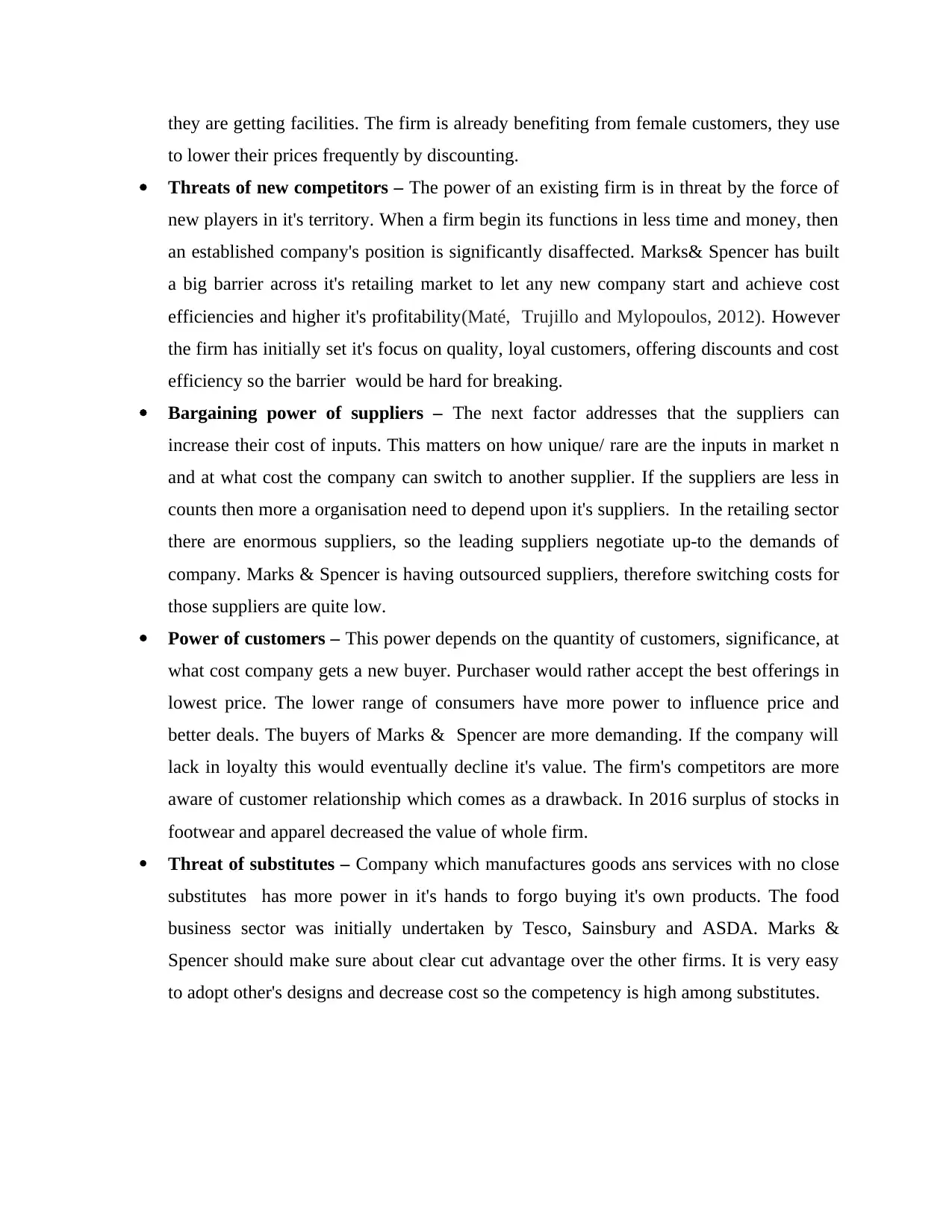
they are getting facilities. The firm is already benefiting from female customers, they use
to lower their prices frequently by discounting.
Threats of new competitors – The power of an existing firm is in threat by the force of
new players in it's territory. When a firm begin its functions in less time and money, then
an established company's position is significantly disaffected. Marks& Spencer has built
a big barrier across it's retailing market to let any new company start and achieve cost
efficiencies and higher it's profitability(Maté, Trujillo and Mylopoulos, 2012). However
the firm has initially set it's focus on quality, loyal customers, offering discounts and cost
efficiency so the barrier would be hard for breaking.
Bargaining power of suppliers – The next factor addresses that the suppliers can
increase their cost of inputs. This matters on how unique/ rare are the inputs in market n
and at what cost the company can switch to another supplier. If the suppliers are less in
counts then more a organisation need to depend upon it's suppliers. In the retailing sector
there are enormous suppliers, so the leading suppliers negotiate up-to the demands of
company. Marks & Spencer is having outsourced suppliers, therefore switching costs for
those suppliers are quite low.
Power of customers – This power depends on the quantity of customers, significance, at
what cost company gets a new buyer. Purchaser would rather accept the best offerings in
lowest price. The lower range of consumers have more power to influence price and
better deals. The buyers of Marks & Spencer are more demanding. If the company will
lack in loyalty this would eventually decline it's value. The firm's competitors are more
aware of customer relationship which comes as a drawback. In 2016 surplus of stocks in
footwear and apparel decreased the value of whole firm.
Threat of substitutes – Company which manufactures goods ans services with no close
substitutes has more power in it's hands to forgo buying it's own products. The food
business sector was initially undertaken by Tesco, Sainsbury and ASDA. Marks &
Spencer should make sure about clear cut advantage over the other firms. It is very easy
to adopt other's designs and decrease cost so the competency is high among substitutes.
to lower their prices frequently by discounting.
Threats of new competitors – The power of an existing firm is in threat by the force of
new players in it's territory. When a firm begin its functions in less time and money, then
an established company's position is significantly disaffected. Marks& Spencer has built
a big barrier across it's retailing market to let any new company start and achieve cost
efficiencies and higher it's profitability(Maté, Trujillo and Mylopoulos, 2012). However
the firm has initially set it's focus on quality, loyal customers, offering discounts and cost
efficiency so the barrier would be hard for breaking.
Bargaining power of suppliers – The next factor addresses that the suppliers can
increase their cost of inputs. This matters on how unique/ rare are the inputs in market n
and at what cost the company can switch to another supplier. If the suppliers are less in
counts then more a organisation need to depend upon it's suppliers. In the retailing sector
there are enormous suppliers, so the leading suppliers negotiate up-to the demands of
company. Marks & Spencer is having outsourced suppliers, therefore switching costs for
those suppliers are quite low.
Power of customers – This power depends on the quantity of customers, significance, at
what cost company gets a new buyer. Purchaser would rather accept the best offerings in
lowest price. The lower range of consumers have more power to influence price and
better deals. The buyers of Marks & Spencer are more demanding. If the company will
lack in loyalty this would eventually decline it's value. The firm's competitors are more
aware of customer relationship which comes as a drawback. In 2016 surplus of stocks in
footwear and apparel decreased the value of whole firm.
Threat of substitutes – Company which manufactures goods ans services with no close
substitutes has more power in it's hands to forgo buying it's own products. The food
business sector was initially undertaken by Tesco, Sainsbury and ASDA. Marks &
Spencer should make sure about clear cut advantage over the other firms. It is very easy
to adopt other's designs and decrease cost so the competency is high among substitutes.
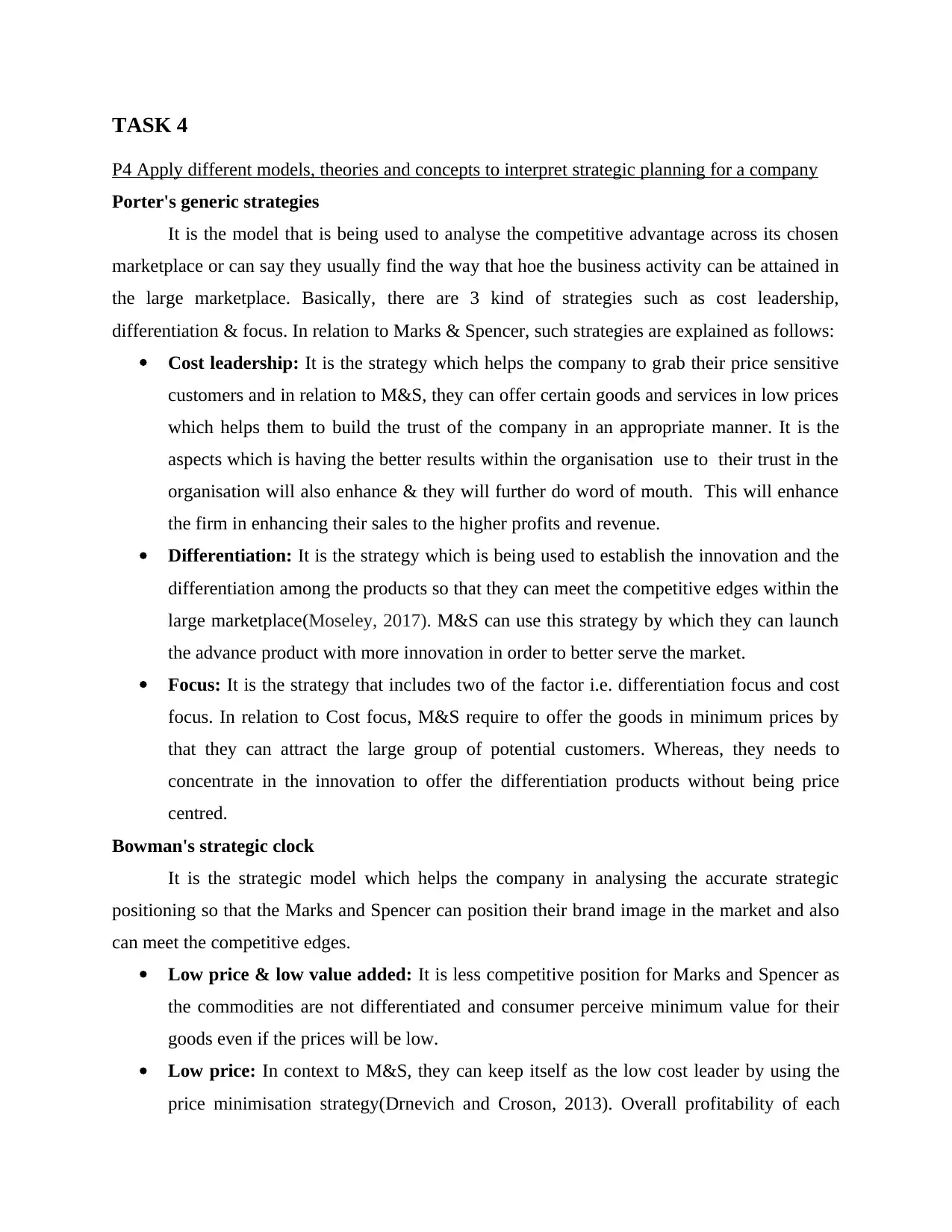
TASK 4
P4 Apply different models, theories and concepts to interpret strategic planning for a company
Porter's generic strategies
It is the model that is being used to analyse the competitive advantage across its chosen
marketplace or can say they usually find the way that hoe the business activity can be attained in
the large marketplace. Basically, there are 3 kind of strategies such as cost leadership,
differentiation & focus. In relation to Marks & Spencer, such strategies are explained as follows:
Cost leadership: It is the strategy which helps the company to grab their price sensitive
customers and in relation to M&S, they can offer certain goods and services in low prices
which helps them to build the trust of the company in an appropriate manner. It is the
aspects which is having the better results within the organisation use to their trust in the
organisation will also enhance & they will further do word of mouth. This will enhance
the firm in enhancing their sales to the higher profits and revenue.
Differentiation: It is the strategy which is being used to establish the innovation and the
differentiation among the products so that they can meet the competitive edges within the
large marketplace(Moseley, 2017). M&S can use this strategy by which they can launch
the advance product with more innovation in order to better serve the market.
Focus: It is the strategy that includes two of the factor i.e. differentiation focus and cost
focus. In relation to Cost focus, M&S require to offer the goods in minimum prices by
that they can attract the large group of potential customers. Whereas, they needs to
concentrate in the innovation to offer the differentiation products without being price
centred.
Bowman's strategic clock
It is the strategic model which helps the company in analysing the accurate strategic
positioning so that the Marks and Spencer can position their brand image in the market and also
can meet the competitive edges.
Low price & low value added: It is less competitive position for Marks and Spencer as
the commodities are not differentiated and consumer perceive minimum value for their
goods even if the prices will be low.
Low price: In context to M&S, they can keep itself as the low cost leader by using the
price minimisation strategy(Drnevich and Croson, 2013). Overall profitability of each
P4 Apply different models, theories and concepts to interpret strategic planning for a company
Porter's generic strategies
It is the model that is being used to analyse the competitive advantage across its chosen
marketplace or can say they usually find the way that hoe the business activity can be attained in
the large marketplace. Basically, there are 3 kind of strategies such as cost leadership,
differentiation & focus. In relation to Marks & Spencer, such strategies are explained as follows:
Cost leadership: It is the strategy which helps the company to grab their price sensitive
customers and in relation to M&S, they can offer certain goods and services in low prices
which helps them to build the trust of the company in an appropriate manner. It is the
aspects which is having the better results within the organisation use to their trust in the
organisation will also enhance & they will further do word of mouth. This will enhance
the firm in enhancing their sales to the higher profits and revenue.
Differentiation: It is the strategy which is being used to establish the innovation and the
differentiation among the products so that they can meet the competitive edges within the
large marketplace(Moseley, 2017). M&S can use this strategy by which they can launch
the advance product with more innovation in order to better serve the market.
Focus: It is the strategy that includes two of the factor i.e. differentiation focus and cost
focus. In relation to Cost focus, M&S require to offer the goods in minimum prices by
that they can attract the large group of potential customers. Whereas, they needs to
concentrate in the innovation to offer the differentiation products without being price
centred.
Bowman's strategic clock
It is the strategic model which helps the company in analysing the accurate strategic
positioning so that the Marks and Spencer can position their brand image in the market and also
can meet the competitive edges.
Low price & low value added: It is less competitive position for Marks and Spencer as
the commodities are not differentiated and consumer perceive minimum value for their
goods even if the prices will be low.
Low price: In context to M&S, they can keep itself as the low cost leader by using the
price minimisation strategy(Drnevich and Croson, 2013). Overall profitability of each
Secure Best Marks with AI Grader
Need help grading? Try our AI Grader for instant feedback on your assignments.
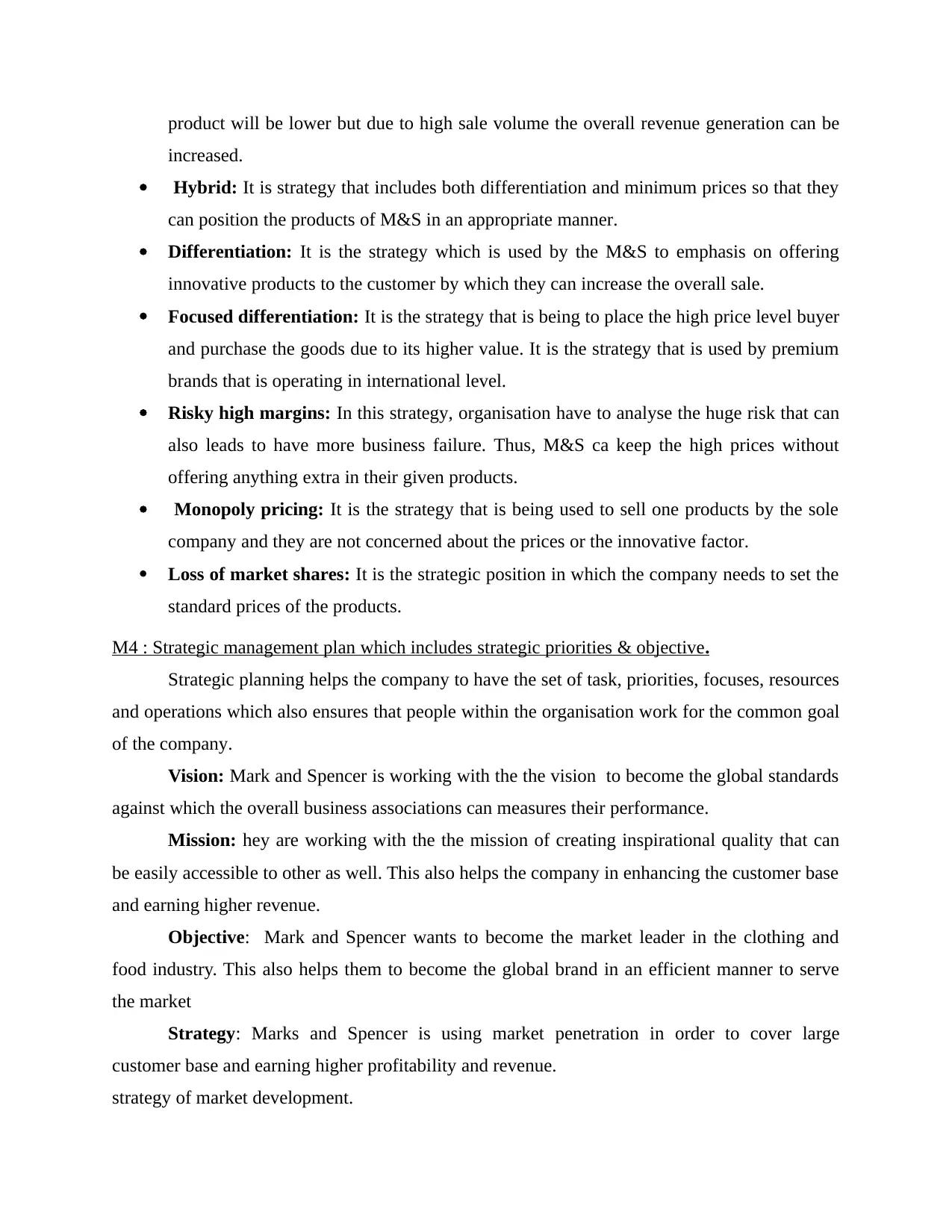
product will be lower but due to high sale volume the overall revenue generation can be
increased.
Hybrid: It is strategy that includes both differentiation and minimum prices so that they
can position the products of M&S in an appropriate manner.
Differentiation: It is the strategy which is used by the M&S to emphasis on offering
innovative products to the customer by which they can increase the overall sale.
Focused differentiation: It is the strategy that is being to place the high price level buyer
and purchase the goods due to its higher value. It is the strategy that is used by premium
brands that is operating in international level.
Risky high margins: In this strategy, organisation have to analyse the huge risk that can
also leads to have more business failure. Thus, M&S ca keep the high prices without
offering anything extra in their given products.
Monopoly pricing: It is the strategy that is being used to sell one products by the sole
company and they are not concerned about the prices or the innovative factor.
Loss of market shares: It is the strategic position in which the company needs to set the
standard prices of the products.
M4 : Strategic management plan which includes strategic priorities & objective.
Strategic planning helps the company to have the set of task, priorities, focuses, resources
and operations which also ensures that people within the organisation work for the common goal
of the company.
Vision: Mark and Spencer is working with the the vision to become the global standards
against which the overall business associations can measures their performance.
Mission: hey are working with the the mission of creating inspirational quality that can
be easily accessible to other as well. This also helps the company in enhancing the customer base
and earning higher revenue.
Objective: Mark and Spencer wants to become the market leader in the clothing and
food industry. This also helps them to become the global brand in an efficient manner to serve
the market
Strategy: Marks and Spencer is using market penetration in order to cover large
customer base and earning higher profitability and revenue.
strategy of market development.
increased.
Hybrid: It is strategy that includes both differentiation and minimum prices so that they
can position the products of M&S in an appropriate manner.
Differentiation: It is the strategy which is used by the M&S to emphasis on offering
innovative products to the customer by which they can increase the overall sale.
Focused differentiation: It is the strategy that is being to place the high price level buyer
and purchase the goods due to its higher value. It is the strategy that is used by premium
brands that is operating in international level.
Risky high margins: In this strategy, organisation have to analyse the huge risk that can
also leads to have more business failure. Thus, M&S ca keep the high prices without
offering anything extra in their given products.
Monopoly pricing: It is the strategy that is being used to sell one products by the sole
company and they are not concerned about the prices or the innovative factor.
Loss of market shares: It is the strategic position in which the company needs to set the
standard prices of the products.
M4 : Strategic management plan which includes strategic priorities & objective.
Strategic planning helps the company to have the set of task, priorities, focuses, resources
and operations which also ensures that people within the organisation work for the common goal
of the company.
Vision: Mark and Spencer is working with the the vision to become the global standards
against which the overall business associations can measures their performance.
Mission: hey are working with the the mission of creating inspirational quality that can
be easily accessible to other as well. This also helps the company in enhancing the customer base
and earning higher revenue.
Objective: Mark and Spencer wants to become the market leader in the clothing and
food industry. This also helps them to become the global brand in an efficient manner to serve
the market
Strategy: Marks and Spencer is using market penetration in order to cover large
customer base and earning higher profitability and revenue.
strategy of market development.
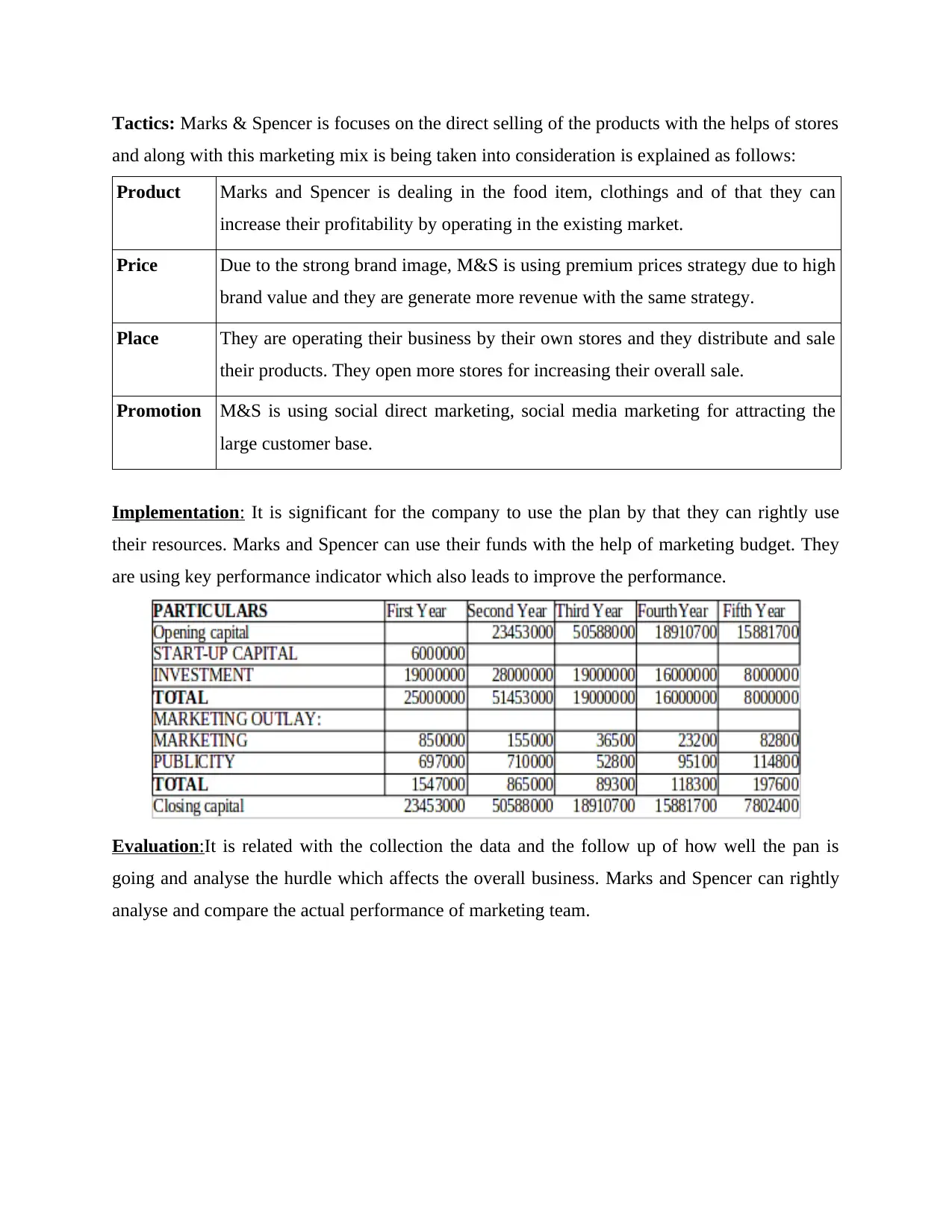
Tactics: Marks & Spencer is focuses on the direct selling of the products with the helps of stores
and along with this marketing mix is being taken into consideration is explained as follows:
Product Marks and Spencer is dealing in the food item, clothings and of that they can
increase their profitability by operating in the existing market.
Price Due to the strong brand image, M&S is using premium prices strategy due to high
brand value and they are generate more revenue with the same strategy.
Place They are operating their business by their own stores and they distribute and sale
their products. They open more stores for increasing their overall sale.
Promotion M&S is using social direct marketing, social media marketing for attracting the
large customer base.
Implementation: It is significant for the company to use the plan by that they can rightly use
their resources. Marks and Spencer can use their funds with the help of marketing budget. They
are using key performance indicator which also leads to improve the performance.
Evaluation:It is related with the collection the data and the follow up of how well the pan is
going and analyse the hurdle which affects the overall business. Marks and Spencer can rightly
analyse and compare the actual performance of marketing team.
and along with this marketing mix is being taken into consideration is explained as follows:
Product Marks and Spencer is dealing in the food item, clothings and of that they can
increase their profitability by operating in the existing market.
Price Due to the strong brand image, M&S is using premium prices strategy due to high
brand value and they are generate more revenue with the same strategy.
Place They are operating their business by their own stores and they distribute and sale
their products. They open more stores for increasing their overall sale.
Promotion M&S is using social direct marketing, social media marketing for attracting the
large customer base.
Implementation: It is significant for the company to use the plan by that they can rightly use
their resources. Marks and Spencer can use their funds with the help of marketing budget. They
are using key performance indicator which also leads to improve the performance.
Evaluation:It is related with the collection the data and the follow up of how well the pan is
going and analyse the hurdle which affects the overall business. Marks and Spencer can rightly
analyse and compare the actual performance of marketing team.
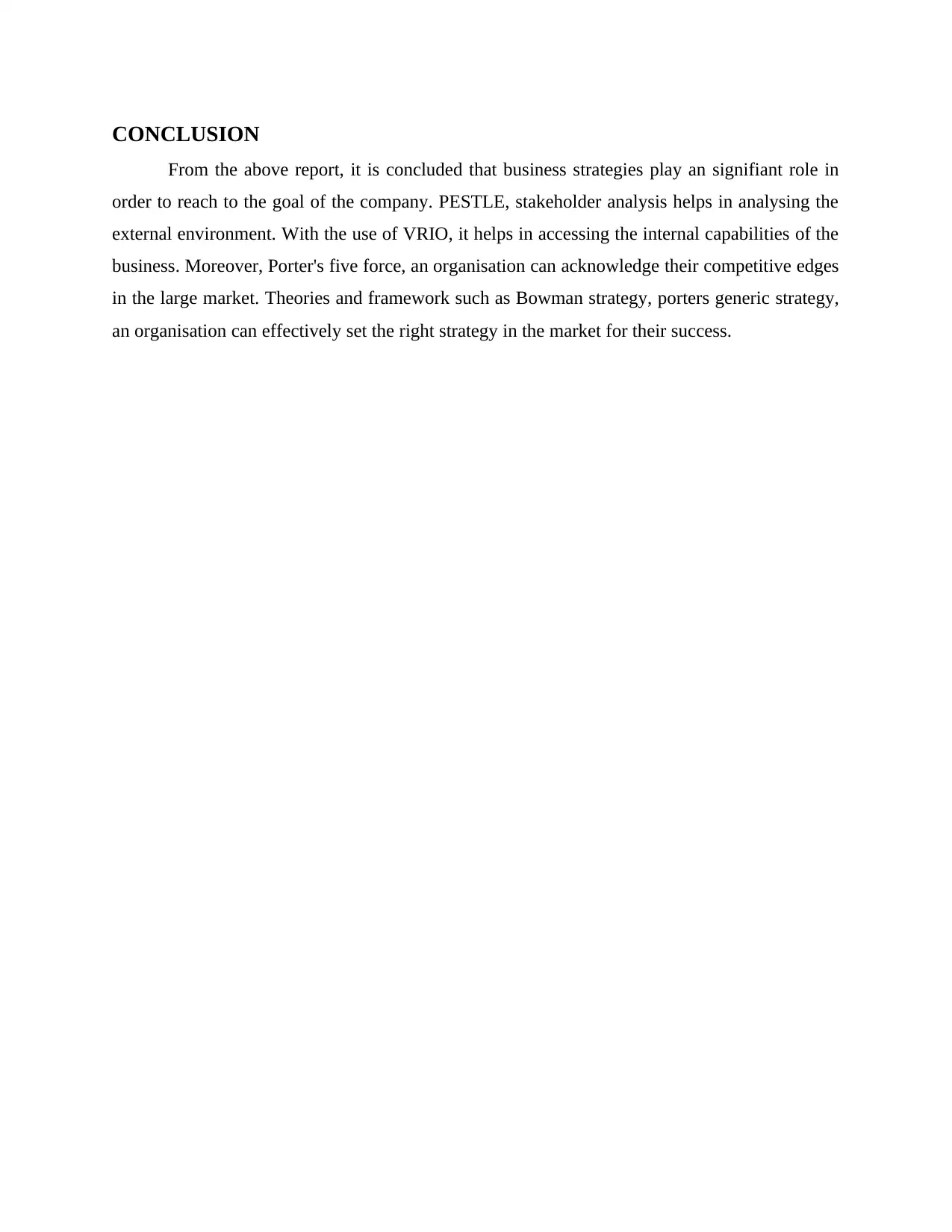
CONCLUSION
From the above report, it is concluded that business strategies play an signifiant role in
order to reach to the goal of the company. PESTLE, stakeholder analysis helps in analysing the
external environment. With the use of VRIO, it helps in accessing the internal capabilities of the
business. Moreover, Porter's five force, an organisation can acknowledge their competitive edges
in the large market. Theories and framework such as Bowman strategy, porters generic strategy,
an organisation can effectively set the right strategy in the market for their success.
From the above report, it is concluded that business strategies play an signifiant role in
order to reach to the goal of the company. PESTLE, stakeholder analysis helps in analysing the
external environment. With the use of VRIO, it helps in accessing the internal capabilities of the
business. Moreover, Porter's five force, an organisation can acknowledge their competitive edges
in the large market. Theories and framework such as Bowman strategy, porters generic strategy,
an organisation can effectively set the right strategy in the market for their success.
Paraphrase This Document
Need a fresh take? Get an instant paraphrase of this document with our AI Paraphraser
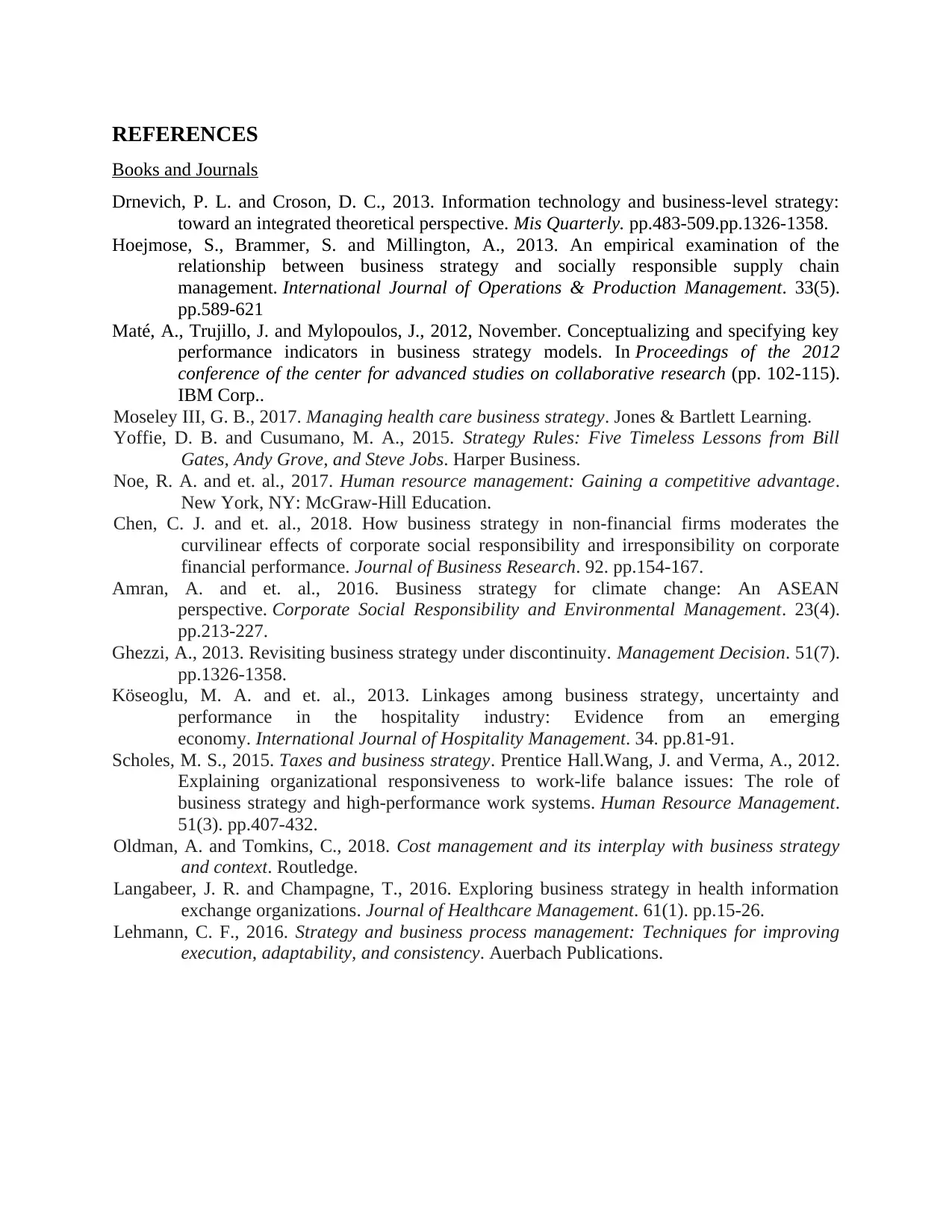
REFERENCES
Books and Journals
Drnevich, P. L. and Croson, D. C., 2013. Information technology and business-level strategy:
toward an integrated theoretical perspective. Mis Quarterly. pp.483-509.pp.1326-1358.
Hoejmose, S., Brammer, S. and Millington, A., 2013. An empirical examination of the
relationship between business strategy and socially responsible supply chain
management. International Journal of Operations & Production Management. 33(5).
pp.589-621
Maté, A., Trujillo, J. and Mylopoulos, J., 2012, November. Conceptualizing and specifying key
performance indicators in business strategy models. In Proceedings of the 2012
conference of the center for advanced studies on collaborative research (pp. 102-115).
IBM Corp..
Moseley III, G. B., 2017. Managing health care business strategy. Jones & Bartlett Learning.
Yoffie, D. B. and Cusumano, M. A., 2015. Strategy Rules: Five Timeless Lessons from Bill
Gates, Andy Grove, and Steve Jobs. Harper Business.
Noe, R. A. and et. al., 2017. Human resource management: Gaining a competitive advantage.
New York, NY: McGraw-Hill Education.
Chen, C. J. and et. al., 2018. How business strategy in non-financial firms moderates the
curvilinear effects of corporate social responsibility and irresponsibility on corporate
financial performance. Journal of Business Research. 92. pp.154-167.
Amran, A. and et. al., 2016. Business strategy for climate change: An ASEAN
perspective. Corporate Social Responsibility and Environmental Management. 23(4).
pp.213-227.
Ghezzi, A., 2013. Revisiting business strategy under discontinuity. Management Decision. 51(7).
pp.1326-1358.
Köseoglu, M. A. and et. al., 2013. Linkages among business strategy, uncertainty and
performance in the hospitality industry: Evidence from an emerging
economy. International Journal of Hospitality Management. 34. pp.81-91.
Scholes, M. S., 2015. Taxes and business strategy. Prentice Hall.Wang, J. and Verma, A., 2012.
Explaining organizational responsiveness to work‐life balance issues: The role of
business strategy and high‐performance work systems. Human Resource Management.
51(3). pp.407-432.
Oldman, A. and Tomkins, C., 2018. Cost management and its interplay with business strategy
and context. Routledge.
Langabeer, J. R. and Champagne, T., 2016. Exploring business strategy in health information
exchange organizations. Journal of Healthcare Management. 61(1). pp.15-26.
Lehmann, C. F., 2016. Strategy and business process management: Techniques for improving
execution, adaptability, and consistency. Auerbach Publications.
Books and Journals
Drnevich, P. L. and Croson, D. C., 2013. Information technology and business-level strategy:
toward an integrated theoretical perspective. Mis Quarterly. pp.483-509.pp.1326-1358.
Hoejmose, S., Brammer, S. and Millington, A., 2013. An empirical examination of the
relationship between business strategy and socially responsible supply chain
management. International Journal of Operations & Production Management. 33(5).
pp.589-621
Maté, A., Trujillo, J. and Mylopoulos, J., 2012, November. Conceptualizing and specifying key
performance indicators in business strategy models. In Proceedings of the 2012
conference of the center for advanced studies on collaborative research (pp. 102-115).
IBM Corp..
Moseley III, G. B., 2017. Managing health care business strategy. Jones & Bartlett Learning.
Yoffie, D. B. and Cusumano, M. A., 2015. Strategy Rules: Five Timeless Lessons from Bill
Gates, Andy Grove, and Steve Jobs. Harper Business.
Noe, R. A. and et. al., 2017. Human resource management: Gaining a competitive advantage.
New York, NY: McGraw-Hill Education.
Chen, C. J. and et. al., 2018. How business strategy in non-financial firms moderates the
curvilinear effects of corporate social responsibility and irresponsibility on corporate
financial performance. Journal of Business Research. 92. pp.154-167.
Amran, A. and et. al., 2016. Business strategy for climate change: An ASEAN
perspective. Corporate Social Responsibility and Environmental Management. 23(4).
pp.213-227.
Ghezzi, A., 2013. Revisiting business strategy under discontinuity. Management Decision. 51(7).
pp.1326-1358.
Köseoglu, M. A. and et. al., 2013. Linkages among business strategy, uncertainty and
performance in the hospitality industry: Evidence from an emerging
economy. International Journal of Hospitality Management. 34. pp.81-91.
Scholes, M. S., 2015. Taxes and business strategy. Prentice Hall.Wang, J. and Verma, A., 2012.
Explaining organizational responsiveness to work‐life balance issues: The role of
business strategy and high‐performance work systems. Human Resource Management.
51(3). pp.407-432.
Oldman, A. and Tomkins, C., 2018. Cost management and its interplay with business strategy
and context. Routledge.
Langabeer, J. R. and Champagne, T., 2016. Exploring business strategy in health information
exchange organizations. Journal of Healthcare Management. 61(1). pp.15-26.
Lehmann, C. F., 2016. Strategy and business process management: Techniques for improving
execution, adaptability, and consistency. Auerbach Publications.
1 out of 14
Related Documents
Your All-in-One AI-Powered Toolkit for Academic Success.
+13062052269
info@desklib.com
Available 24*7 on WhatsApp / Email
![[object Object]](/_next/static/media/star-bottom.7253800d.svg)
Unlock your academic potential
© 2024 | Zucol Services PVT LTD | All rights reserved.


